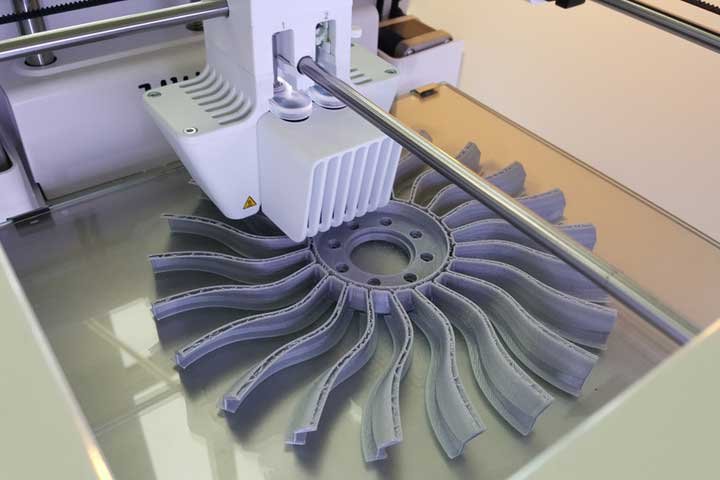3D printing and additive manufacturing (AM) are transforming aircraft production by enabling more efficient, cost-effective, and innovative manufacturing processes. These technologies are widely used across the aerospace sector for prototyping, production of complex components, and reducing material waste. Here’s a detailed look at how these advanced technologies are utilized in aircraft production:
1. Lightweight Components
- Optimized Designs:
- Additive manufacturing allows for the creation of intricate geometries that are not feasible with traditional methods, such as lattice structures.
- These designs reduce weight while maintaining or enhancing structural integrity.
- Applications:
- Lightweight brackets, air ducts, and structural components in aircraft cabins and wings.
- Example: Airbus uses 3D-printed brackets and components in the A350 XWB to achieve weight savings.
2. Prototyping and Design Validation
- Rapid Prototyping:
- 3D printing accelerates the design validation process by producing prototypes quickly and cost-effectively.
- Designers can test and refine parts iteratively without the need for expensive tooling.
- Applications:
- Wind tunnel models for aerodynamic testing.
- Functional prototypes of complex components like engine parts or landing gear.
3. Complex and Custom Components
- Geometric Freedom:
- Additive manufacturing enables the production of parts with complex internal channels, such as cooling systems or fuel manifolds, which are challenging to produce using traditional methods.
- Customization:
- Custom-fit parts for specific aircraft configurations or modifications can be produced on demand.
- Applications:
- Turbine blades with integrated cooling channels in jet engines.
- Bespoke interior components for business and VIP aircraft.
4. Reduction in Material Waste
- Material Efficiency:
- Unlike subtractive manufacturing, which removes material to create a shape, additive manufacturing builds parts layer by layer, minimizing waste.
- Applications:
- High-value materials like titanium and nickel alloys, which are expensive and prone to significant waste in traditional machining, are used more efficiently.
- Example:
- GE Aviation’s fuel nozzle for the LEAP engine, produced via AM, consolidates 20 parts into one and reduces material waste.
5. Reduced Lead Times and Costs
- Tooling Reduction:
- Traditional manufacturing often requires specialized tooling, which is costly and time-consuming to produce. AM eliminates the need for tooling in many cases.
- Shortened Production Cycles:
- Components can be manufactured faster, enabling quicker turnaround times for production and delivery.
- Applications:
- Replacement parts for legacy aircraft can be printed on demand, reducing the need for maintaining large inventories.
6. Improved Performance and Durability
- Enhanced Strength:
- Parts can be designed with optimized material distribution to withstand specific stresses, improving performance.
- Applications:
- Jet engine components produced using AM can handle higher temperatures and pressures, improving fuel efficiency and engine life.
7. Sustainability and Environmental Impact
- Lower Carbon Footprint:
- Reduced material waste and lighter components contribute to more fuel-efficient aircraft, decreasing overall emissions.
- Sustainable Materials:
- Development of recyclable and bio-based materials for 3D printing supports environmental goals.
- Example:
- Boeing uses 3D-printed parts made from recycled carbon fiber in its aircraft.
8. On-Demand Manufacturing and Supply Chain Benefits
- Decentralized Production:
- AM enables localized production, reducing dependence on complex supply chains.
- On-Demand Spare Parts:
- Airlines and MRO (Maintenance, Repair, and Overhaul) providers can print spare parts as needed, reducing storage costs and lead times.
- Applications:
- Printing of replacement cabin panels, air ducts, or minor structural components directly at maintenance facilities.
9. Applications in Engines and Aerostructures
- Jet Engines:
- Additive manufacturing is widely used for critical engine components, such as fuel nozzles, turbine blades, and heat exchangers.
- Example: GE Aviation’s 3D-printed fuel nozzle in the LEAP engine is 25% lighter and five times more durable.
- Aerostructures:
- Wing components, fuselage sections, and landing gear parts are increasingly produced using AM.
10. Emerging Materials in Additive Manufacturing
- Metal Additives:
- Titanium, aluminum, and nickel-based alloys are widely used for their strength, lightweight properties, and heat resistance.
- High-Performance Polymers:
- Materials like PEEK (Polyether Ether Ketone) and ULTEM are used for non-load-bearing components in the cabin and avionics.
- Composites:
- Fiber-reinforced polymers are being developed for AM, combining the benefits of composites with the flexibility of 3D printing.
Examples of Industry Adoption
- Airbus:
- The A350 XWB features over 1,000 3D-printed parts, including brackets and ventilation components.
- Boeing:
- 3D-printed structural parts are used in the Boeing 777X and the Starliner spacecraft.
- GE Aviation:
- The LEAP engine and GE9X engines include several AM components for improved performance and reduced weight.
- Rolls-Royce:
- Uses AM to produce turbine blades and other critical engine components.
Challenges in Adopting 3D Printing and AM
- Certification and Regulatory Approval:
- Aerospace components must meet stringent safety and reliability standards, making certification a lengthy process.
- Material Limitations:
- While AM materials are advancing, they are not yet suitable for all aerospace applications.
- Cost of Technology:
- Initial investment in AM equipment and training can be high.
- Scalability:
- While AM is excellent for low-volume production, scaling up for mass production remains a challenge.
Future Trends
- Larger and More Complex Structures:
- Advances in AM technology will enable the production of larger aerostructures like entire fuselage sections or wings.
- Digital Twins:
- Integration of AM with digital twin technology for optimized design and real-time monitoring during production.
- Hybrid Manufacturing:
- Combining AM with traditional methods to leverage the strengths of both approaches.
- Sustainability Focus:
- Increased use of sustainable materials and closed-loop recycling systems in AM processes.
Conclusion
3D printing and additive manufacturing are revolutionizing the aerospace industry by enabling innovative designs, reducing weight, minimizing waste, and shortening production cycles. As the technology continues to advance, it is expected to play an even more significant role in the future of aircraft manufacturing, making production more efficient, sustainable, and responsive to evolving industry demands.
Hashtags
#AdditiveManufacturing #3DPrinting #3DPrintingInAerospace #AMInAerospace #AdvancedManufacturing #Aerospace3DPrinting #3DPrintedAircraftParts #AdditiveInAviation #AircraftComponents #PrecisionManufacturing #ManufacturingInnovation #AMTechnology #DigitalManufacturing #TechInAerospace #NextGenManufacturing #SustainableManufacturing













